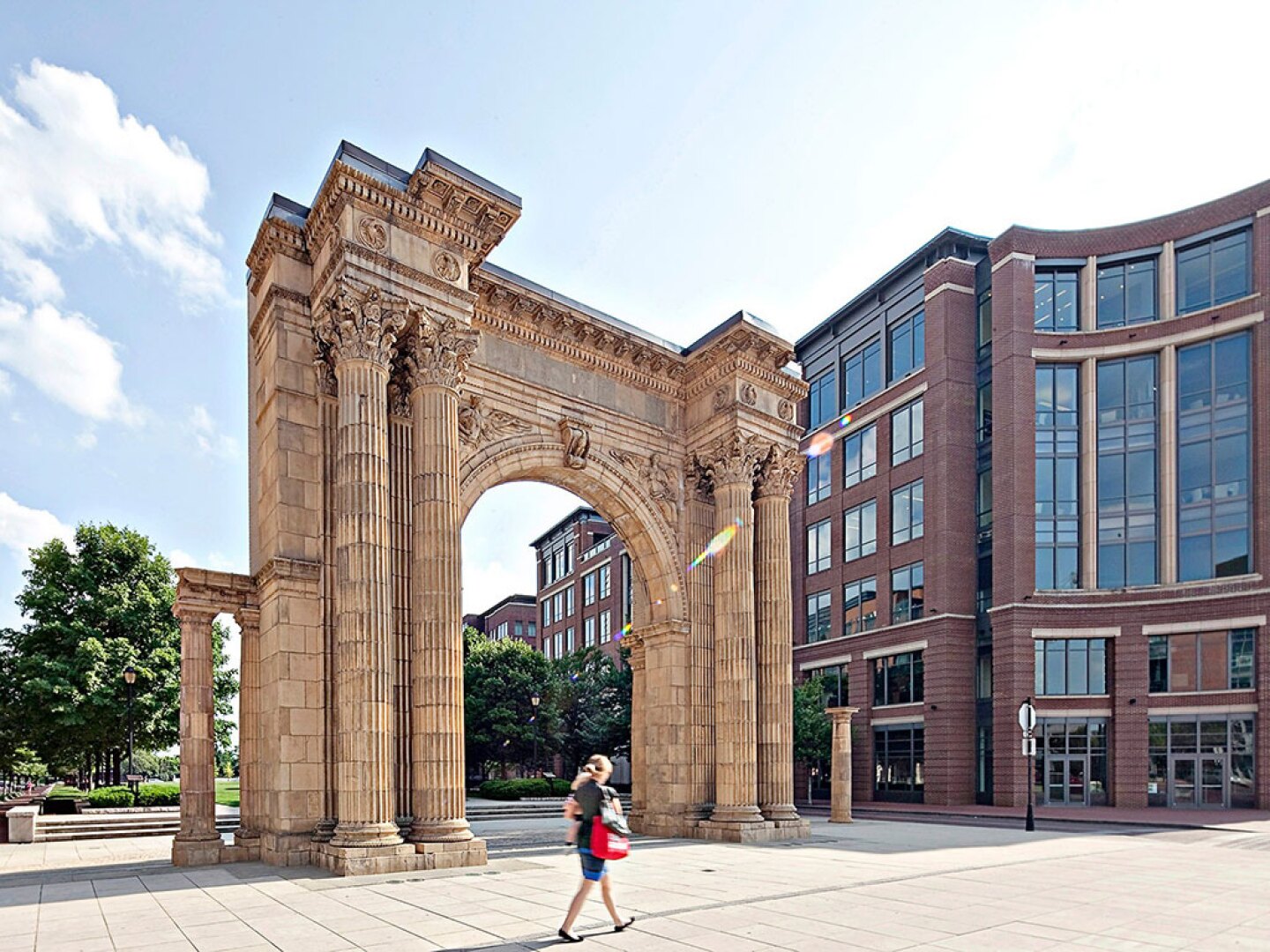In cities large and small around the world—from Columbus, Ohio, to Valencia, Spain—a major focus of modern urban revitalization has been the addition of new sports arenas, purposely built in concert with supportive, mixed-use developments that can become self-sustaining neighborhoods.
No longer content to build standalone stadiums with acres of parking that may be vacant or underutilized for long periods—and may have little or no direct benefit to the surrounding neighborhoods—city planners instead are leaning into a new model of large sports facility, one that puts a busy year-round complex at the center of a larger, thriving community. In the United States alone, the pipeline for these types of so-called sports districts over the next decade is projected to be tens of billions of dollars—and quickly gaining traction as an engine of major urban revitalization.
More important than the large size of these projects is their adaptability. In Europe, for example, where large acreage isn’t readily available to build at U.S. scale, new sports facilities can still capture similar benefits by integrating micro-parks, plazas, supporter squares, and other proven features into the complex. With more sophisticated, community-oriented approaches to venue design and programming, the economic activity typical of game days in nearby bars, restaurants, and retail shops can quickly be extended past these events to create active, year-round neighborhoods—and help redefine the very fabric of a city.
What’s driving this new approach and the influx of capital? And what can we expect from the next generation of sports-anchored districts?
Isolated “spaceships” vs. rebuilding cities
The radical evolution of stadium, ballpark, and arena architecture has occurred over a relatively brief period. The birth of modern-day sports facilities is largely attributed to the design of Arrowhead Stadium and Kauffman Stadium in Kansas City, Missouri, in the early 1970s. Both were among the earliest examples of single-purpose venues with modern amenities.
However, those stadiums are surrounded by a sea of parking, just off I-70, and are nearly 15 minutes from the heart of downtown. Like many other sports venues that came in later years, they lack thoughtful pedestrian scale or community connection. They function much like isolated spaceships—massive structures in the middle of a city, daunting in size and scale, with many missed opportunities to be valuable neighbors.
So what has changed?

Twenty-five years ago, Nationwide Arena opened in Columbus, Ohio, and inspired a new era of community-centric venues and sports-oriented developments. It also gave many cities the case study they needed to pursue similar redevelopment. Led by Nationwide Realty Investors, MKSK, and HOK, the project was seen as a catalyst for strategic reinvestment in the city,
(HOK)
A standard-setting arena district
Isolated stadiums are quickly becoming a thing of the past. Today’s team owners, investors, and city planners—armed with benchmark data from past projects—are now looking to build sports complexes that will have transformational impact on a city, including 24/7 neighborhoods and mixed-use developments that can thrive economically regardless of game days.
Twenty-five years ago, Nationwide Arena opened in Columbus, Ohio, and inspired a new era of community-centric venues and sports-oriented developments. It also gave many cities the case study they needed to pursue similar redevelopment. Led by Nationwide Realty Investors, MKSK, and HOK, the project was seen as a catalyst for strategic reinvestment in the city, with more than 100 acres (40.5 ha) of arena-adjacent land converted into mixed-use and public spaces, including valuable infrastructure. Dubbed by The New York Times as “one of the Midwest’s most successful urban redevelopment projects,” the Nationwide Arena District challenged the car-centric status quo of modern stadium design by created a pedestrian-friendly tapestry of development that continues to expand.
Investment in civic infrastructure can be rare and politically tumultuous. The development of a major sports facility offers a city a critical opportunity to seize the moment and vigorously advocate for more public infrastructure—green spaces, trails, accessibility, etc.—better community-oriented designs of the actual complex, and a quicker pace of development than might traditionally be expected.
These new sports-themed districts, which almost always include a significant residential component, often materialize in just a matter of years and ensure healthy economic activity year-round. By leveraging billions of dollars in public and private funds, sports teams, cities, and developers can deliver long-term urban value to their communities. The ICE District in Edmonton, Canada, is a prime example of the efficiency with which district development can happen with a motivated team and sports anchor. In less than a decade, the district opened the Rogers Place arena, several office towers, a 346-room hotel, and expanses of infill development.
Looking ahead to the next decade, one thing is clear: the next generation of sports-anchored, mixed-use districts will share the goals of their predecessors but take a completely different approach.
Extending the engagement zone
The outward-facing elements of tomorrow’s sports venues—including green space, retail frontage, public parks, and community gathering spaces—aim to blur the lines between venue and city by providing residents, visitors, and passersby with ready access to numerous attractions such as mini concerts, pop-up stores, pickup games, hiking, biking, and more. In Jacksonville, Florida, plans to overhaul the city’s NFL stadium include a “public wellness loop” around the venue to promote community well-being.

Above and below: Energizer Park, a new major-league soccer stadium in St. Louis, uses public green spaces to extend the ticketed zone. As fans move to the site from downtown, these thoughtfully planned and landscaped spaces offer impromptu social gathering spaces. Plazas are often used for pre- or postgame entertainment, encouraging spectators to arrive early and stay late.
(Michael Robinson/HOK)
These types of strategies also take event days into account. Energizer Park, a new MLS stadium in St. Louis, uses public green spaces to extend the ticketed zone. As fans move to the site from downtown, these thoughtfully planned and landscaped spaces offer impromptu social gathering spaces. Plazas are often used for pre- or postgame entertainment, encouraging spectators to arrive early and stay late. In Valencia, Spain, the recently opened Roig Arena boasts a grand staircase, public plazas, and terraces, all within a pedestrian-priority zone. The arena’s urban planning strategies seamlessly connect the site to a four-acre [1.6 ha] public park.
Hospitality-centric development
Residential development, luxury apartments, and hotels have long been critical to activating sports-anchored, mixed-use districts. However, the way in which sports venues are used beyond game days to facilitate hospitality is evolving.
Some venues are simply looking to maximize the economic potential of premium spaces such as clubs, restaurants, and bars by opening them to corporate events. Others are exploring ways to capitalize on their own spaces with more conferences and conventions. By combining two major pieces of civic infrastructure, cities can ensure daily use of the venue—and positively influence the architecture to be more sophisticated and hospitality-oriented. For example, adjacent or connected hotel development might give visitors views of the field or offer exclusive access.
The rise of themed districts
Tomorrow’s sports-anchored, mixed-use districts will be better integrated with the larger civic missions of their host city, giving developers even greater incentive to continue reinvesting in the surrounding district. Beyond the restaurants, retail, and residential development, these districts represent unique branding opportunities to reinforce a city’s identity. They can also embody a broader commitment to neighborhood wellness with trails, green spaces, yoga and nutrition classes, health clinics, exercise facilities, and farmers markets.
Or perhaps the venue chooses to reiterate a city’s dedication to innovation, with a district dedicated to collaboration on research and technology, sports sciences, and academic partnerships. Public spaces could be used to facilitate networking between the maker and innovator communities; a stadium site could house labs and research spaces; and tenants in the surrounding district might include universities, tech companies, themed food and beverage spaces, and more. Even nontraditional tenants and neighbors—museums, nonprofits, cultural institutions—can further reinforce a broader focus on community and leverage the district as a platform for connection.
A seamless district experience
The rapid evolution of technology in these new sports-anchored districts will streamline the visitor’s experience in ways both seen and unseen. Immersive displays that engage people with a team’s brand or a city’s broader mission might populate critical pedestrian paths throughout the district. Digital video boards and engaging signage can emphasize a complex’s multipurpose nature and its quick adaptability to events both inside and outside the venue. On game days, this technology would offer fans a frictionless experience in ticketing, cashless purchases, and seamless sponsor activations that make the district as much a destination as the stadium itself.
Technology and digital signage also will play a crucial role in achieving citywide circulation goals. Wayfinding and signage can reinforce the district’s walkability, accessibility, and convenience while embracing the multimodal arrival and departure experience with easy access to public transit.
Collegiate venues and campus opportunities
Cities aren’t the only ones exploring new sports complex models. Universities, navigating the impact of Name, Image and Likeness (NIL) on athletic department finances and facing increased government scrutiny, are seeking new ways to generate revenue. Mixed-use developments could fill an important void, literally and figuratively. Many universities control sizable tracts that are undeveloped, and mixed-use projects on that land could provide a vital, seamless link between the stadium and the central campus.
At both the University of Notre Dame and Auburn University, football stadium redevelopment projects have included significant academic space with the goal of creating vibrant campus centers that are always active, not just on game days. Universities are now looking at how to further diversify development to create more economically resilient zones beyond the confines of the stadium, integrating amenities such as boutique hotels, unique retail offerings, and innovation spaces that form a true campus hub.
From city centers to college campuses, the sports-anchored districts of the future promise to be more diverse, more walkable, and more embedded in their neighborhoods. With billions of dollars potentially pouring into these future projects, cities, teams, investors, and developers have an opportunity to create memorable, lasting civic infrastructure whose benefits extend far beyond the stadium’s walls.
More on Sports-Driven Developments:







